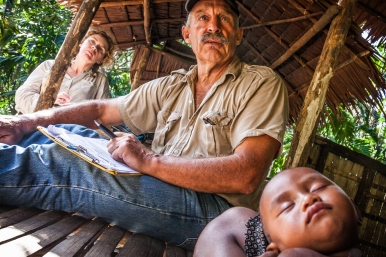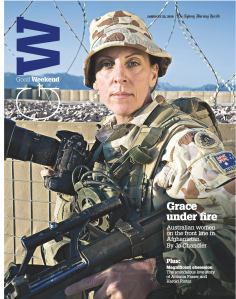THE MONTHLY: APRIL 2023 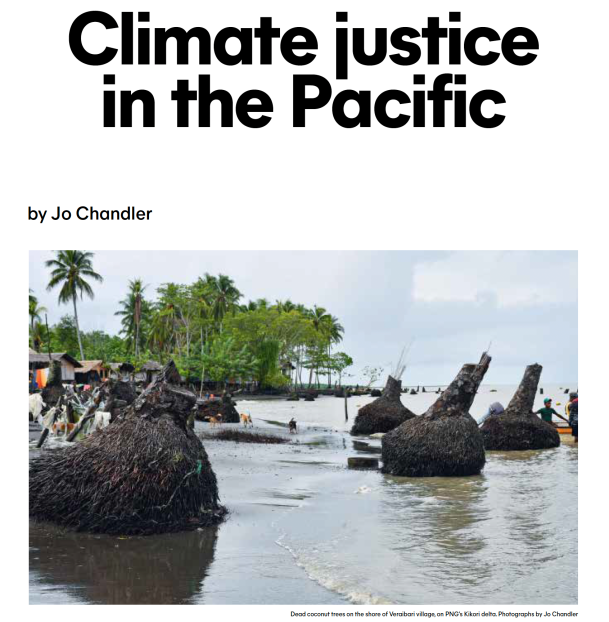
“It strikes me, after 14 years (on and off) reporting from all over PNG, that climate damage is the most tangible return many grassroots people have ever known on those gazillions of gallons of extracted fossil-fuel wealth.” I spent a couple of weeks last year visiting three villages in PNG dealing with climate impacts – two coastal, one in the highlands. My aim was to try to share the stories of ordinary people dealing with rising tides and extreme, shifting weather – people who have little information and zero resources. And then to think about what climate justice might look like if it is to find its way to these people. The article is published this month in The Monthly. Thanks to the dozens of people who shared their stories and knowledge, many who are not named in the story. And to the Walkley Foundation Sean Dorney Pacific Journalism Grant. Link is here: https://www.themonthly.com.au/issue/2023/april/jo-chandler/climate-justice-pacific
MEANJIN: SUMMER 2023
PNG’S WOMEN IN WAITING 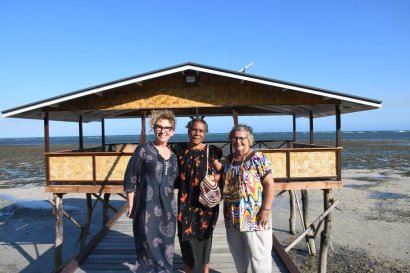 The two women, venerable grandmothers and veteran activists, are plotting revolution and dissecting the exercise of feminine power in Papua New Guinea over plates of fish and chips and salad. PNG – reflecting the Pacific reality – has among the lowest levels of female political representation in the world. This essay reflects on a decade of reporting on efforts by PNG women to get elected, and the obstacles before them. Link is here. $Paywall, but if you are a PNG or Pasifika journalist, researcher or activist with an interest in this issue, contact me directly for access: jo.m.chandler@gmail.com. (Photo: Cherished photo of me with the two amazing women at Tutu Beach – Dr Orovu Sepoe and Dame Carol Kidu.)
The two women, venerable grandmothers and veteran activists, are plotting revolution and dissecting the exercise of feminine power in Papua New Guinea over plates of fish and chips and salad. PNG – reflecting the Pacific reality – has among the lowest levels of female political representation in the world. This essay reflects on a decade of reporting on efforts by PNG women to get elected, and the obstacles before them. Link is here. $Paywall, but if you are a PNG or Pasifika journalist, researcher or activist with an interest in this issue, contact me directly for access: jo.m.chandler@gmail.com. (Photo: Cherished photo of me with the two amazing women at Tutu Beach – Dr Orovu Sepoe and Dame Carol Kidu.)
THE MONTHLY: APRIL 2019
DRY AT THE MOUTH: WITNESSING THE ECOLOGICAL COLLAPSE OF THE COORONG
 In this story, once again I circle back to revisit and deepen previous reporting. I’ve tagged along with University of Adelaide biologist and bird expert Dr David Paton’s annual summer surveys of the sublime Coorong area of South Australia several times over the years, most memorably taking my kids along as volunteers when they were small. They plucked tiny birds out of mist nets and weighed them, sifted the water for tiny larvae, released pygmy possums out of field traps, and after the washing up was done in the field camp, did jigsaws and talked about the wild world with actual scientists. It was a beautiful time in a magical place, but already we felt we were witnessing its vanishing. Worst fears are being realised. My story for The Monthly is here.
In this story, once again I circle back to revisit and deepen previous reporting. I’ve tagged along with University of Adelaide biologist and bird expert Dr David Paton’s annual summer surveys of the sublime Coorong area of South Australia several times over the years, most memorably taking my kids along as volunteers when they were small. They plucked tiny birds out of mist nets and weighed them, sifted the water for tiny larvae, released pygmy possums out of field traps, and after the washing up was done in the field camp, did jigsaws and talked about the wild world with actual scientists. It was a beautiful time in a magical place, but already we felt we were witnessing its vanishing. Worst fears are being realised. My story for The Monthly is here.
THE LANCET: DECEMBER 2018
FIGHTING A POLIO OUTBREAK IN PNG
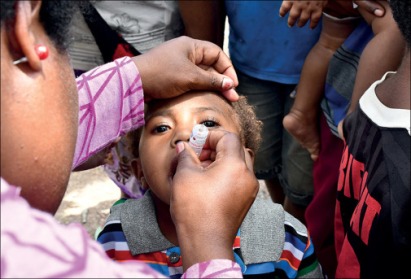 When I went to Nigeria in April 2017 to research a story (for The Atlantic and Undark) on the efforts there to stamp out polio, I couldn’t help but be grateful – and a bit mystified – that the disease had been absent so long from Papua New Guinea. With only a small proportion of the country having access to proper toilets and clean water, and collapsing low vaccination rates, PNG appeared vulnerable to this wily and opportunistic virus. And then, in 2018, polio returned after an 18 year absence. During my research trip in September that year, I filed this report for The Lancet’s World Report section on the campaign to stop the spread. The story is available free, though you may be required to register an email address to get access: Link is here.
When I went to Nigeria in April 2017 to research a story (for The Atlantic and Undark) on the efforts there to stamp out polio, I couldn’t help but be grateful – and a bit mystified – that the disease had been absent so long from Papua New Guinea. With only a small proportion of the country having access to proper toilets and clean water, and collapsing low vaccination rates, PNG appeared vulnerable to this wily and opportunistic virus. And then, in 2018, polio returned after an 18 year absence. During my research trip in September that year, I filed this report for The Lancet’s World Report section on the campaign to stop the spread. The story is available free, though you may be required to register an email address to get access: Link is here.
THE MONTHLY: NOVEMBER 2018
EN ROUTE TO APEC: A TALE OF TWO ROADS
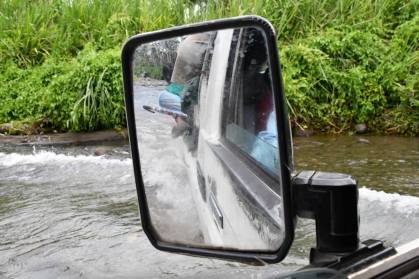 In November 2018, I was winding up a research trip which included looking at the health crisis in PNG for a story commissioned for The New York Times, and then travelling to a remote part of Oro province where a vast area had been signed over for conservation – putting it out of the reach of palm oil and miners – after decades of negotiations with the landowners. As I returned to Port Moresby, the city was getting ready to host world leaders gathering for the APEC Summit – most notoriously purchasing a fleet of Maseratis to chauffeur dignitaries around. It provided a moment to reflect on so many stark contrasts – economic, social, physical, political, aspirational. Over the course of one long day, I travelled two very different roads, from a PNG village to APEC Haus. This is what I saw and heard. Link here to my story in The Monthly.
In November 2018, I was winding up a research trip which included looking at the health crisis in PNG for a story commissioned for The New York Times, and then travelling to a remote part of Oro province where a vast area had been signed over for conservation – putting it out of the reach of palm oil and miners – after decades of negotiations with the landowners. As I returned to Port Moresby, the city was getting ready to host world leaders gathering for the APEC Summit – most notoriously purchasing a fleet of Maseratis to chauffeur dignitaries around. It provided a moment to reflect on so many stark contrasts – economic, social, physical, political, aspirational. Over the course of one long day, I travelled two very different roads, from a PNG village to APEC Haus. This is what I saw and heard. Link here to my story in The Monthly.
THE MONTHLY: MAY 2018
PNG’S RESOURCE CURSE
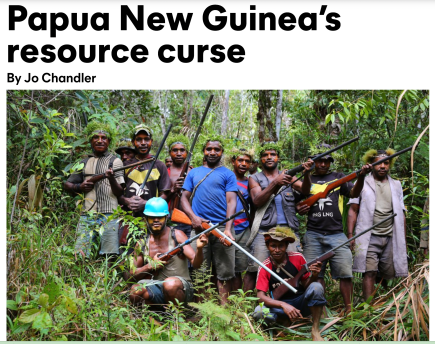 The first trip I made to PNG, for The Age and Sydney Morning Herald back in 2009, was largely focused on looking at the impacts of the then fledgling and much hyped ExxonMobil-lead PNGLNG project up in what is now Hela Province. It was supposed to bring prosperity to the region and the nation – double GDP was the promise. A dozen trips older and wiser, I went back. This is the deeply worrying, and heartbreaking, story of what I found. Published by The Monthly magazine: Link is here.
The first trip I made to PNG, for The Age and Sydney Morning Herald back in 2009, was largely focused on looking at the impacts of the then fledgling and much hyped ExxonMobil-lead PNGLNG project up in what is now Hela Province. It was supposed to bring prosperity to the region and the nation – double GDP was the promise. A dozen trips older and wiser, I went back. This is the deeply worrying, and heartbreaking, story of what I found. Published by The Monthly magazine: Link is here.
THE ATLANTIC: OCTOBER 2017
THE THREAT OF POLIO IN THE BADLANDS OF BOKO HARAM
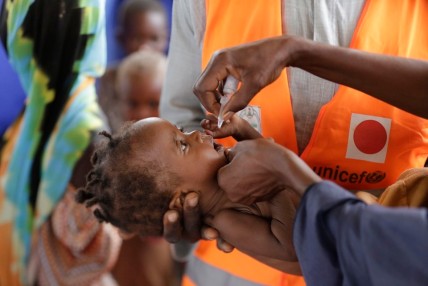 It’s costing more than $1 billion a year to hang onto the ground won on polio and, inch by inch, to overcome religious resistance, cultural mistrust, and a backlash within vulnerable communities where the disease has faded from memory and more immediate crises—other diseases, lack of food, political strife—can seem a higher priority than polio vaccine. If the war on polio is to be won, it must run the gamut of all these—as well as the terrorizing resistance of violent men with guns. Link here to The Atlantic. This story was commissioned and published originally by Undark, link here.
It’s costing more than $1 billion a year to hang onto the ground won on polio and, inch by inch, to overcome religious resistance, cultural mistrust, and a backlash within vulnerable communities where the disease has faded from memory and more immediate crises—other diseases, lack of food, political strife—can seem a higher priority than polio vaccine. If the war on polio is to be won, it must run the gamut of all these—as well as the terrorizing resistance of violent men with guns. Link here to The Atlantic. This story was commissioned and published originally by Undark, link here.
THE MONTHLY MAGAZINE: MARCH 2017
THE TOTTEN HOTS UP
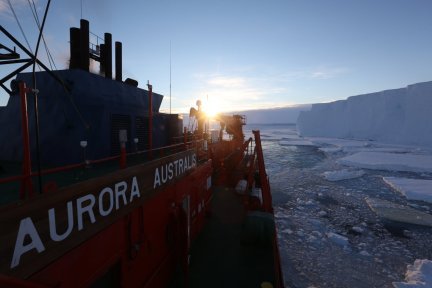 Throughout the geologically brief climate sweet spot that human civilisation has enjoyed, spared the orbital meanderings that have spun our planet in and out of ice ages, Totten’s flow has hummed obligingly in neutral. Put simply, it has maintained its “glacial mass balance”, whereby snowfall coming in and ice flowing out equals a negligible shift in sea levels. Now it appears Totten has slipped into gear. Link here.
Throughout the geologically brief climate sweet spot that human civilisation has enjoyed, spared the orbital meanderings that have spun our planet in and out of ice ages, Totten’s flow has hummed obligingly in neutral. Put simply, it has maintained its “glacial mass balance”, whereby snowfall coming in and ice flowing out equals a negligible shift in sea levels. Now it appears Totten has slipped into gear. Link here.
This story was awarded the Melbourne Press Club Quill Award for Best Feature.
THE MONTHLY MAGAZINE: JUNE 2016
GRAVE BARRIER REEF
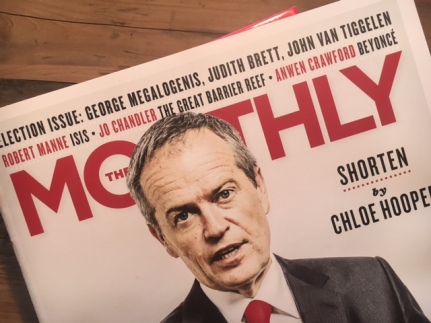 We were diving in dissolving reef. The water had this terrible green ghostly quality – it was like diving in ectoplasm. It was awful. And essentially it was dying coral.” In the June edition of The Monthly I have a long piece on the devastating coral bleaching now playing out on the Great Barrier Reef. At the same time as news emerges that
We were diving in dissolving reef. The water had this terrible green ghostly quality – it was like diving in ectoplasm. It was awful. And essentially it was dying coral.” In the June edition of The Monthly I have a long piece on the devastating coral bleaching now playing out on the Great Barrier Reef. At the same time as news emerges that
the Australian Government has censored a UN report on the condition of the Reef and other iconic World Heritage sites for fear of frightening off tourists, scientists talk to me about their distress. What – if anything – can save the Great Barrier Reef? Link here.
COSMOS MAGAZINE: JANUARY 2016
IN THE FOOTSTEPS OF WALLACE
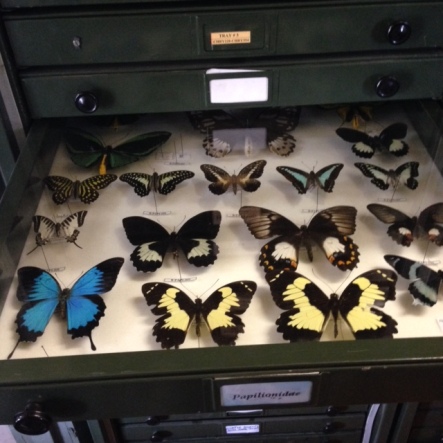 Vojtech Novotny is a Czech entomologist who first travelled to Papua New Guinea 20 years ago. He came for the insects. He stayed for the people. Having heard much about him over the years, it was a thrill to visit his laboratory and field sites in Madang. The profile I’ve written is published in the December/January edition of Cosmos Magazine. He talks about his scientific journey, and his reflections on the precarious fate of the PNG tropical forests. Link is here.
Vojtech Novotny is a Czech entomologist who first travelled to Papua New Guinea 20 years ago. He came for the insects. He stayed for the people. Having heard much about him over the years, it was a thrill to visit his laboratory and field sites in Madang. The profile I’ve written is published in the December/January edition of Cosmos Magazine. He talks about his scientific journey, and his reflections on the precarious fate of the PNG tropical forests. Link is here.
THE MONTHLY MAGAZINE: MAY 2015
GUT FEELINGS
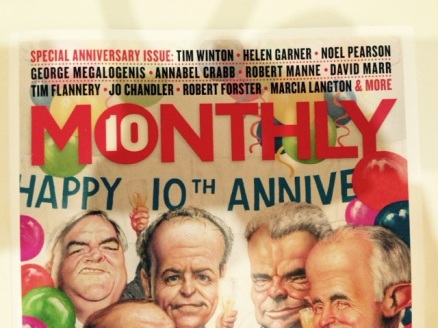 ‘You are very atypical for a human.’ This was the verdict of the microbiology team which evaluated the microbial population in my gut. This article for the special 10th anniversary edition of The Monthly explores the exploding medical frontier of the microbiome, ‘a seething ecosystem that has to be kept in balance and fed and maintained’. In the past few years new technology has delivered the step change equivalent of a telescope to explore our microbial dark matter, finally allowing science to begin to understand its potentially profound influence on our health and wellbeing. Now unlocked! You can find it here: https://www.themonthly.com.au/issue/2015/may/1430402400/jo-chandler/gut-feelings
‘You are very atypical for a human.’ This was the verdict of the microbiology team which evaluated the microbial population in my gut. This article for the special 10th anniversary edition of The Monthly explores the exploding medical frontier of the microbiome, ‘a seething ecosystem that has to be kept in balance and fed and maintained’. In the past few years new technology has delivered the step change equivalent of a telescope to explore our microbial dark matter, finally allowing science to begin to understand its potentially profound influence on our health and wellbeing. Now unlocked! You can find it here: https://www.themonthly.com.au/issue/2015/may/1430402400/jo-chandler/gut-feelings
THE MONTHLY MAGAZINE: FEBRUARY 2015
 MANUS IN THE BALANCE
MANUS IN THE BALANCE
Life outside the detention centres on Manus Island: There’s another Manus Island you’d never recognise in Australian headlines. Beguiling, beautiful, baffling, it confounded Margaret Mead for 50 years. It was changed utterly by World War II, and is now undergoing another uninvited seismic change courtesy of Australia’s asylum seeker policy – ‘re-colonialsm’ some call it. Is this what the future of immigration policy looks like? It’s bought money, jobs, prostitution, deaths, social tension and environmental stress. Pictures: Vlad Sokhin.
https://www.themonthly.com.au/issue/2015/february/1422709200/jo-chandler/manus-balance
NEW SCIENTIST JUNE 2014
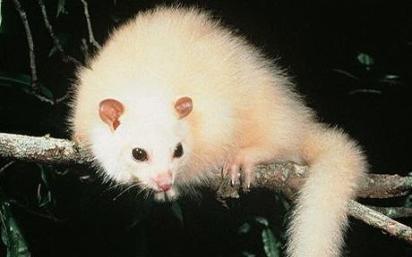 GHOST OF THE CLOUD FOREST
GHOST OF THE CLOUD FOREST
We enter Australia’s lost world of species marooned by evolution to meet one of its rarest, a creature uniquely vulnerable to climate change.
IT TAKES less than three hours to travel from the busy tarmac of Cairns Airport, back 100 million years to Queensland’s primeval Wet Tropics rainforest. By the time the sprawling malls and suburban estates have given way to blue sky and sugar cane, we have already rewound several decades. Veering inland, we swim against the tourist tide streaming towards the Great Barrier Reef. As jungle encloses us, the notion that we have crossed into a more primitive dimension is encouraged by road signs cautioning drivers to watch out for southern cassowaries – stroppy, flightless birds sometimes likened to prehistoric turkeys. My feature for New Scientist magazine on the search for the vanishing – vanished? – lemuroid white possum. Link here (paywall).
(This piece was re-published by New Scientist in September 2016 in a “best-of” collection of features entitled ‘Living Planet’.)
THE WEEKEND AUSTRALIAN MAGAZINE: 6/4/13 (Picture: Vlad Sokhin)
BUILDER BARRY KIRBY’S LABOUR OF LOVE IN PNG
‘On the best days Barry Kirby might deliver a baby into the arms of a healthy mother. After a difficult labour, he’s as exultant as she is exhausted. On the worst days he treks up to a village hidden in the jungle to find the sister, mother or husband of a woman who has died in childbirth, and will add her story to his overflowing archive of similar sorrows.’ Link here.
GOOD WEEKEND: 3/9/11
‘For now, this skeleton is quietly entrusted to the safekeeping of the state and stored in a vault in the mortuary in Melbourne. There has been no eternal rest for him, rather a series of rude displacements. Records show he has now been twice disinterred – the first time in 1929. This is his third less-than-reverential entombment. If records didn’t show otherwise, Blau’s expert judgment would put the age of the man whose remains are laid before her as nudging 30 years when he died. But he was only 25. These bones travelled many hard miles of Victoria’s wild high country in a relatively short life, and the journey took its toll. “He had incredibly robust muscle attachments on his clavicles,” she explains.  The muscles may be gone, but “where they attach to the bone, there’s an insertion, so the bony artefact of where that was building is still there”. These days, you might see something similar in the bones of serious bodybuilders. But this is the body of a serious horseman, one who traversed great distances working the reins on fast, flighty horses. The rough miles are also clocked up in the compressed vertebra of his spine. “When you get pressure from riding or from carrying very heavy loads, you can actually see a dip in the bones. You see the indicators of a lifestyle. This is a young man, very active, and it shows on the skeleton.”‘
The muscles may be gone, but “where they attach to the bone, there’s an insertion, so the bony artefact of where that was building is still there”. These days, you might see something similar in the bones of serious bodybuilders. But this is the body of a serious horseman, one who traversed great distances working the reins on fast, flighty horses. The rough miles are also clocked up in the compressed vertebra of his spine. “When you get pressure from riding or from carrying very heavy loads, you can actually see a dip in the bones. You see the indicators of a lifestyle. This is a young man, very active, and it shows on the skeleton.”‘
Click here to see the full text.
THE POWER OF ONE:
‘This Dame is an unlikely political fighter — a widow in spectacles, a tidy nana coif and a floral blouse. If not for that mouth and the traditional clan tattoos her mother-in-law inked above one pale wrist long ago, she could slip back to her home town of Shorncliffe in suburban Brisbane, indistinguishable from the 60-somethings enjoying comfortable dowager status and a spritzer at the local golf club. But a teenage romance that turned into a 25-year marriage to one of Papua New Guinea’s most respected figures, and endures as a 40-year love affair with the nation she came to as a bride, mother and teacher, jolted her into an alternate reality. Carol Millwater was seduced first by a man and then by a rich culture of communal care and spirit. She grieves the loss of both. The man’s death was swift and sudden, while the society slowly fractures and diminishes under the thousand cuts of abrupt modernity, corruption, poverty and population growth.’
Click here to see the full text.
GRACE UNDER FIRE
‘The next two weeks will see Corporal Rachel Ingram spending long days in the desert encased in heavy body armour. At least the harsh Afghan summer is finally fading. At the season’s height, the sun was rising, and body armour ordered on, by 4am. “By the end of the day you’re watching the sun drop, begging it, just please, please, go down, go down,” … Sweat will set her long, dark hair like concrete under her helmet and drench her clothes – “soaked, like I’ve jumped in a pool”. She will wriggle out of her gear in the dark, wring it, wipe herself down with Wet Ones – “just the greatest invention in the world” – sleep a deep, stolen soldier’s sleep till she’s nudged awake for her turn on picket, and climb back into her still-damp kit.’
GOOD WEEKEND 9/5/09
A GOOD MAN IN AFRICA
‘Like his guernsey, O’Brien is black and white – the progeny of a tempestuous teenage encounter between two dancers, a daughter of the Amazon and an orphaned son of Africa. Heritier “Harry” O’Brien’s father had found his way to Brazil after picking his way across a border of minefields, aged only 11, to escape the latest pillage of a benighted country then called Zaire. A natural talent – and born survivor – the boy found his way to the corps of the Angolan National Ballet, touring the world, gaining sanctuary in Rio de Janeiro, and fathering the child who has grown up to pace the Collingwood backline.’
You can read an archived text-only version copy of the story here.
HIGHLY COMMENDED: MELBOURNE PRESS CLUB QUILLS
ICE DIARIES
‘The work when we arrive, drilling ice cores to update the climate record, is done over six hours in minus 30°C conditions. We are taking the temperature of the planet, burrowing for a decade of atmospheric history down a 10-metre-deep blue hole. Fingers gloved and frozen, I use my tongue and lower lip to flip the pages in my notebook, while the seasoned scientists peel off their gloves to work, barely wincing. They extract, label and bag the precious lode of ice. The stew I boil for their dinner on the camp stove is cold as soon as I dish it out. My eyelashes – peeking through a woollen polar chador – are heavy with frost. When the truck breaks down 40 kilometres short of our beds at 3am, we jog on the ice in glacier boots and goose-down swaddling, cold seeping into our bones, willing the engine back to work. Eventually, it goes. It’s a small parable of the ice. Antarctica, unseen by humanity even 200 years ago, divines our future and archives our past. It matters to people as never before. It may be, as American writer Barry Lopez so perfectly observed, “a place from which to take the measure of the planet”, but it remains –resolutely unco-operative in that mission.’
You can read a copy of the story here – apologies that it is PDF from a clunky printout version. 
